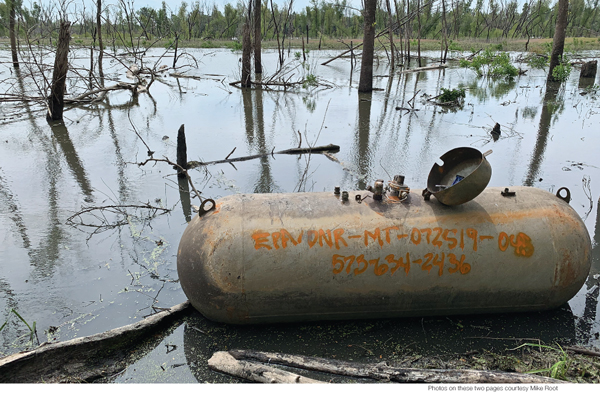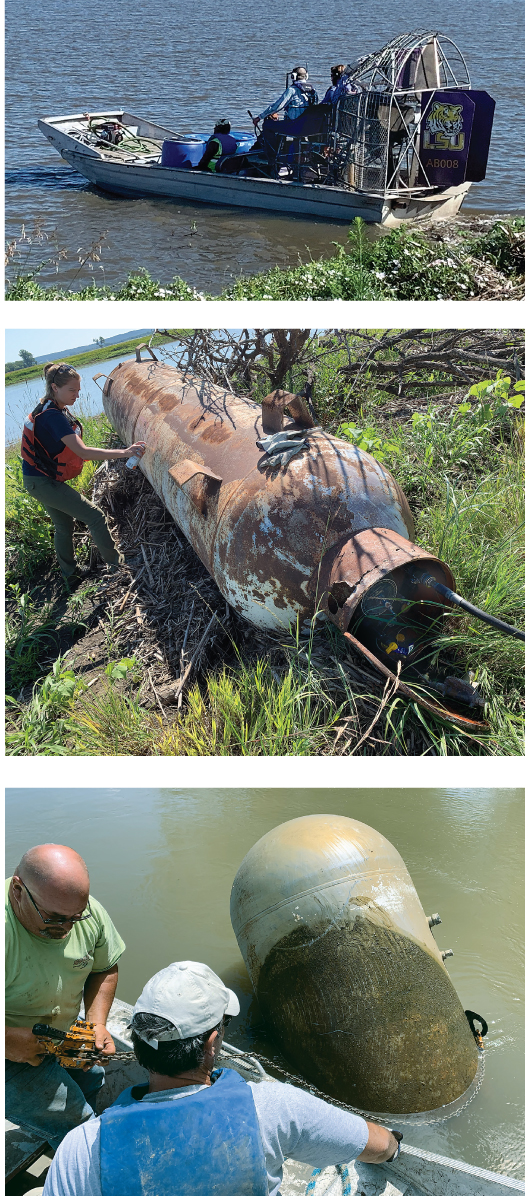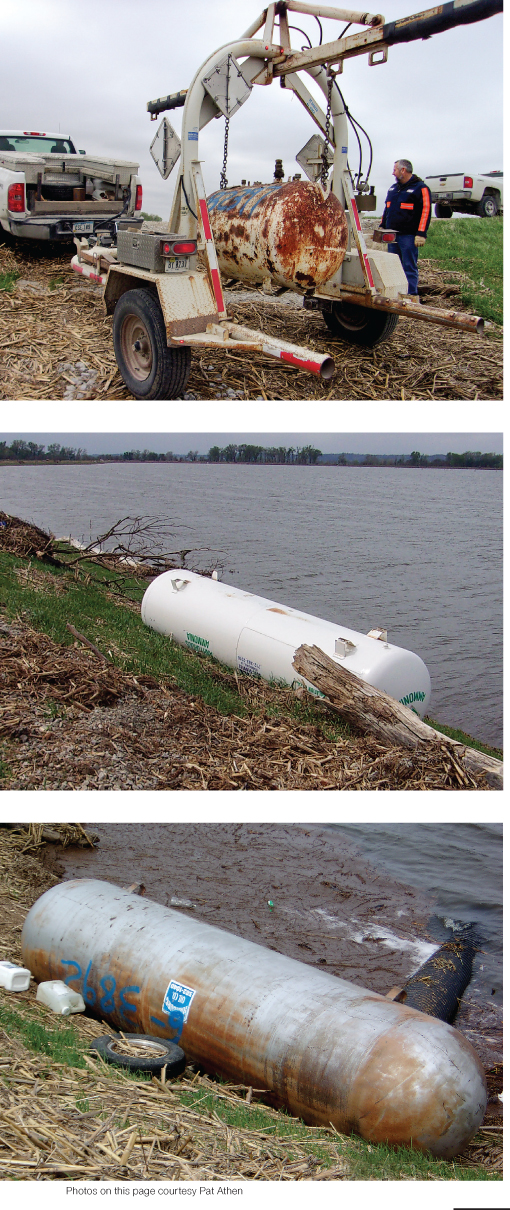Monday, September 16, 2019
(September 16, 2019) — Following a spring and summer of flooding and recovery efforts, retailers in the Midwest have begun adding winter preparation into their already hectic days and weeks. “We wish we could control the weather, but we can’t,” said Paul Harris, fuel division manager at Ray-Carroll Cooperative, which has 10 locations in northwest Missouri. “We can only focus on recovering from the current situation, learning from it, and being as prepared as possible for future challenges.”

In the July issue, BPN covered the flooding in Nebraska, Iowa, Kansas, Missouri, and Arkansas that began in March and continued to cause problems well into the summer as levees failed and rivers suddenly rerouted themselves through fields and everything else in their new path. In mid-June, serious damage from additional flooding continued and Interstate 29 from Omaha to St. Joseph, Mo., which had been reopened, then closed once again for a short period.
For Ray Collins, propane safety director for Sapp Bros. Petroleum (Omaha, Neb.), the relentless flooding meant more and more recovery efforts for the propane operation. While additional roads had opened as of early August, there were some that remained impassible, including roads in and out of the Sapp Bros. Hamburg, Iowa, location. “We are fortunate that we can take care of customers using propane from other locations,” Collins said. “The Hamburg propane storage location might have been in worse shape from continued flooding if it were not for area farmers who built a stronger levee themselves on private property.”
Meanwhile, Sapp Bros. has also been dealing with its travel center near Hamburg, which flooded for a second time in three months in June. “A lot of recovery work was already completed when the second flood hit,” Collins explained at the end of July. “Four new feet of water ruined all of the progress there. New gas lines are having to be run. The travel center now has a target date of mid-August to reopen.” For Collins, despite all the problems, there is pride in the Sapp Bros. team and how they have handled all the situations. “Our team is working hard to restore propane service safely to homes and hopes to be caught up in the August-September timeframe,” he said. “Our techs are often jumping in and helping where needed at other locations. We definitely look forward to a return to normalcy.”

For Ray-Carroll Cooperative, the levee breach at its Brunswick, Mo., location was the only breach to allow water to shut off access to the bulk plant. Other plants sustained damage due to breaches, including limited access caused by road closures. “The water receded and we are working hard to reset tanks, test systems, and have customers prepared for winter,” said Ray-Carroll’s assistant petroleum manager, Dean McFatrich.
MISSOURI PROPANE SAFETY COMMISSION ASSISTS FEMA
For Mike Root, an inspector for the Missouri Propane Safety Commission, a Federal Emergency Management Agency (FEMA) mission assignment requested some propane expertise and he was asked to help. FEMA required the Department of Natural Resources (DNR) and Environmental Protection Agency (EPA) to eliminate the safety risk caused by 364 containers that held a wide variety of hazardous materials. The containers were found in low-
Lying areas in Missouri’s Holt County, where water remained high following numerous levee breaches, some as much as a half-mile long, when rivers simply rerouted onto flat land. These materials included used oil, herbicide, diesel, gasoline, fertilizer, and propane. Of the 364 containers, only 25 were propane tanks. Most of the propane tanks were 500- and 1000-gal. tanks, however, there were a few forklift cylinders and 20-lb cylinders.
“The Missouri Propane Safety Commission agreed to help advise and assist with the processing of the propane tanks,” said Root, who covers the area of northwest Missouri. “The DNR and EPA contracted with a Louisiana company that brought in airboats to navigate the water.” Root explained the airboats were ideal for navigating waters crossing over fallen trees and other debris. In most cases, the tanks were processed but then left to be retrieved later when the water had receded sufficiently. The tanks were marked and secured with a chain or rope. In many cases, there was evidence that someone had tried to secure the various propane tanks that got away, according to Root. He said the majority appeared to be old, privately-owned tanks.
LOOKING AHEAD AND PLANNING FOR WINTER
State government leaders in Missouri, Iowa, Nebraska, and Kansas blame the U.S. Corps of Engineers for placing too much emphasis on habitat management and not enough on flood control. Governors of these states are demanding more control over management of the Missouri River System. Farmers whose land was severely flooded are part of a lawsuit that claims flood control is taking a back seat to slowing the river and restoring habitats that protect the endangered Pallid Sturgeon and shorebirds such as the Piping Plover and Interior Least Tern. The Corps claims it works to balance all priorities and that the excess water came from record rains and melting snow that flowed over frozen ground and directly into the river downstream of its dams.
In July, Missouri Gov. Mike Parson signed an executive order establishing Missouri’s Flood Recovery Advisory Working Group. “Missouri has been plagued by record-level flooding this year. More than 80 levees have overtopped or breached,” Parson said. “The impact of flooding on our citizens and communities has been devastating, costing millions of dollars in property damage. This working group will play a key role in establishing Missouri’s path forward to rebuilding infrastructure, revitalizing damaged farm ground, and refocusing our flood-control priorities.” An initial report to Gov. Parson is to be submitted by Dec. 31 and a final report is due May 31, 2020.

“In many areas, we are just now seeing the full extent of flood damage for the first time as water recedes,” said Greg Noll, executive director of the Propane Marketers Association of Kansas (PMAK). “Other areas remain underwater. The damage is unbelievable. Levees are holding water on the wrong side; backup water has been so severe it has caused more damage than flood waters; entire roads are gone; and once-prime farmland is now replaced by sand. There will be a lot of discussion at government levels about how we move forward as a state.”
In looking ahead to the coming winter season, Noll’s advice to association members is the same as it was during the winter of 2013-2014 when there was a huge propane shortage: “Plan for the worst and hope for the best!” He believes that based on late planting this year, November and December could be big dryer months, so marketers shouldn’t get caught in a position where they cannot supply enough gas.
In Iowa, the state association’s CEO Deb Grooms commented that a recent board meeting included an update on crops in all sections of the state. In short, every region reported the likelihood of a strong crop-drying year due to late planting. Sapp Bros.’ Collins and Ray-Carroll’s McFatrich concurred with Grooms and Noll on the possibilities for a higher-than-average level of late crop drying this year.
As for damage control from future flooding, for retailers it is all about securing tanks and other assets so they don’t float away. “Securing is cheap compared to going out and finding lost assets,” McFatrich said. “We’ve left augers in place for securing assets, in many cases, so that is one step we won’t have to do again.” Like many companies with assets still underwater, there will still be repairs, resets, and regulators to change out ahead of this season.
While McFatrich agrees with Harris that retailers can’t control Mother Nature, he is much more aware of weather situations he should be monitoring that could cause problems weeks and months later. “We are affected more by snowfall and rainfall levels months earlier and hundreds of miles north of us in Minnesota and the Dakotas than we are by current, local snowfall or rainfall. We need to be watching in advance what could soon be causing excess water to flow our way from the north!” — Pat Thornton

In the July issue, BPN covered the flooding in Nebraska, Iowa, Kansas, Missouri, and Arkansas that began in March and continued to cause problems well into the summer as levees failed and rivers suddenly rerouted themselves through fields and everything else in their new path. In mid-June, serious damage from additional flooding continued and Interstate 29 from Omaha to St. Joseph, Mo., which had been reopened, then closed once again for a short period.
For Ray Collins, propane safety director for Sapp Bros. Petroleum (Omaha, Neb.), the relentless flooding meant more and more recovery efforts for the propane operation. While additional roads had opened as of early August, there were some that remained impassible, including roads in and out of the Sapp Bros. Hamburg, Iowa, location. “We are fortunate that we can take care of customers using propane from other locations,” Collins said. “The Hamburg propane storage location might have been in worse shape from continued flooding if it were not for area farmers who built a stronger levee themselves on private property.”
Meanwhile, Sapp Bros. has also been dealing with its travel center near Hamburg, which flooded for a second time in three months in June. “A lot of recovery work was already completed when the second flood hit,” Collins explained at the end of July. “Four new feet of water ruined all of the progress there. New gas lines are having to be run. The travel center now has a target date of mid-August to reopen.” For Collins, despite all the problems, there is pride in the Sapp Bros. team and how they have handled all the situations. “Our team is working hard to restore propane service safely to homes and hopes to be caught up in the August-September timeframe,” he said. “Our techs are often jumping in and helping where needed at other locations. We definitely look forward to a return to normalcy.”

For Ray-Carroll Cooperative, the levee breach at its Brunswick, Mo., location was the only breach to allow water to shut off access to the bulk plant. Other plants sustained damage due to breaches, including limited access caused by road closures. “The water receded and we are working hard to reset tanks, test systems, and have customers prepared for winter,” said Ray-Carroll’s assistant petroleum manager, Dean McFatrich.
MISSOURI PROPANE SAFETY COMMISSION ASSISTS FEMA
For Mike Root, an inspector for the Missouri Propane Safety Commission, a Federal Emergency Management Agency (FEMA) mission assignment requested some propane expertise and he was asked to help. FEMA required the Department of Natural Resources (DNR) and Environmental Protection Agency (EPA) to eliminate the safety risk caused by 364 containers that held a wide variety of hazardous materials. The containers were found in low-
Lying areas in Missouri’s Holt County, where water remained high following numerous levee breaches, some as much as a half-mile long, when rivers simply rerouted onto flat land. These materials included used oil, herbicide, diesel, gasoline, fertilizer, and propane. Of the 364 containers, only 25 were propane tanks. Most of the propane tanks were 500- and 1000-gal. tanks, however, there were a few forklift cylinders and 20-lb cylinders.
“The Missouri Propane Safety Commission agreed to help advise and assist with the processing of the propane tanks,” said Root, who covers the area of northwest Missouri. “The DNR and EPA contracted with a Louisiana company that brought in airboats to navigate the water.” Root explained the airboats were ideal for navigating waters crossing over fallen trees and other debris. In most cases, the tanks were processed but then left to be retrieved later when the water had receded sufficiently. The tanks were marked and secured with a chain or rope. In many cases, there was evidence that someone had tried to secure the various propane tanks that got away, according to Root. He said the majority appeared to be old, privately-owned tanks.
LOOKING AHEAD AND PLANNING FOR WINTER
State government leaders in Missouri, Iowa, Nebraska, and Kansas blame the U.S. Corps of Engineers for placing too much emphasis on habitat management and not enough on flood control. Governors of these states are demanding more control over management of the Missouri River System. Farmers whose land was severely flooded are part of a lawsuit that claims flood control is taking a back seat to slowing the river and restoring habitats that protect the endangered Pallid Sturgeon and shorebirds such as the Piping Plover and Interior Least Tern. The Corps claims it works to balance all priorities and that the excess water came from record rains and melting snow that flowed over frozen ground and directly into the river downstream of its dams.
In July, Missouri Gov. Mike Parson signed an executive order establishing Missouri’s Flood Recovery Advisory Working Group. “Missouri has been plagued by record-level flooding this year. More than 80 levees have overtopped or breached,” Parson said. “The impact of flooding on our citizens and communities has been devastating, costing millions of dollars in property damage. This working group will play a key role in establishing Missouri’s path forward to rebuilding infrastructure, revitalizing damaged farm ground, and refocusing our flood-control priorities.” An initial report to Gov. Parson is to be submitted by Dec. 31 and a final report is due May 31, 2020.

“In many areas, we are just now seeing the full extent of flood damage for the first time as water recedes,” said Greg Noll, executive director of the Propane Marketers Association of Kansas (PMAK). “Other areas remain underwater. The damage is unbelievable. Levees are holding water on the wrong side; backup water has been so severe it has caused more damage than flood waters; entire roads are gone; and once-prime farmland is now replaced by sand. There will be a lot of discussion at government levels about how we move forward as a state.”
In looking ahead to the coming winter season, Noll’s advice to association members is the same as it was during the winter of 2013-2014 when there was a huge propane shortage: “Plan for the worst and hope for the best!” He believes that based on late planting this year, November and December could be big dryer months, so marketers shouldn’t get caught in a position where they cannot supply enough gas.
In Iowa, the state association’s CEO Deb Grooms commented that a recent board meeting included an update on crops in all sections of the state. In short, every region reported the likelihood of a strong crop-drying year due to late planting. Sapp Bros.’ Collins and Ray-Carroll’s McFatrich concurred with Grooms and Noll on the possibilities for a higher-than-average level of late crop drying this year.
As for damage control from future flooding, for retailers it is all about securing tanks and other assets so they don’t float away. “Securing is cheap compared to going out and finding lost assets,” McFatrich said. “We’ve left augers in place for securing assets, in many cases, so that is one step we won’t have to do again.” Like many companies with assets still underwater, there will still be repairs, resets, and regulators to change out ahead of this season.
While McFatrich agrees with Harris that retailers can’t control Mother Nature, he is much more aware of weather situations he should be monitoring that could cause problems weeks and months later. “We are affected more by snowfall and rainfall levels months earlier and hundreds of miles north of us in Minnesota and the Dakotas than we are by current, local snowfall or rainfall. We need to be watching in advance what could soon be causing excess water to flow our way from the north!” — Pat Thornton

